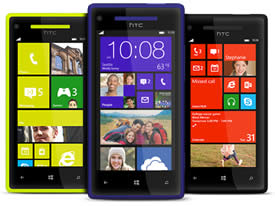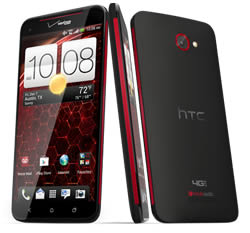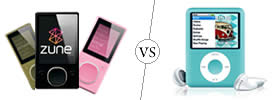Difference between HTC Windows 8X and HTC Droid DNA
Key Difference: The HTC Windows 8X sports a 4.3- inch S-LCD2 capacitive touchscreen that provides a pixel density of 342ppi. The screen is protected using gorilla glass 2, which makes it pretty durable and less prone to scratches. The phone is pretty slick and slim, weighing only 130 grams with the battery. The HTC Butterfly is a high-end phone by the HTC Corporation. The HTC Butterfly is sold in four variants: Droid DNA; J Butterfly HTL21; Butterfly X920d; and Butterfly X920e. They are all powered on a Quad-core 1.5 GHz Krait processor. The HTC Droid has the Quadcomm MDM615m, while the Butterfly variants have the Qualcomm APQ8064 chipset. They all have 2 GB of RAM.
 HTC originally made many phones with Windows OS, before shifting its products to Android for drawing in more customers and profits. Recently, HTC has put focus on helping Windows boost its product range with the new HTC Windows 8X and the 8S phones. The phones are set to give direct competition to the Androids and the iPhones. The company has set out to prove that Windows can be just as stylish and productive as the other phones in the market. HTC has incorporated some of its best technologies on the Windows 8X. The phone was released in November 2012 and has been proven a success with many people.
HTC originally made many phones with Windows OS, before shifting its products to Android for drawing in more customers and profits. Recently, HTC has put focus on helping Windows boost its product range with the new HTC Windows 8X and the 8S phones. The phones are set to give direct competition to the Androids and the iPhones. The company has set out to prove that Windows can be just as stylish and productive as the other phones in the market. HTC has incorporated some of its best technologies on the Windows 8X. The phone was released in November 2012 and has been proven a success with many people.
The HTC Windows 8X sports a 4.3- inch S-LCD2 capacitive touchscreen that provides a pixel density of 342ppi. The screen is protected using gorilla glass 2, which makes it pretty durable and less prone to scratches. The screen itself has an excellent resolution and provides more ppi than the iPhone, giving the users a crisp, clear and sharp display screen. The phone is pretty slick and slim, weighing only 130 grams with the battery. The phone is encased in a polycarbonate chassis that is also durable and does not scratch easy. The matte finish on the back provides a firmer grip on the phone. The power/lock key is located on the top of the phone, while the tray with pin release hole, a volume rocker, and a camera button is placed on the right side of the device. The left side is bare and the bottom holds the charging socket and the primary mic. The buttons are said to be a little too flush, making it difficult to locate them on the screen by touch and even harder to press them.
Under the hood, the device is powered by 1.5 GHz Dual-core Qualcomm processor. It offers the Windows 8 OS, with the live tiles that are customizable based on the user’s preferences. The device offers 1 GB RAM and an internal storage capacity of 16 GB. This is one of the downfalls of the phone, as the 16 GB (minus the space required for internal software) is all the user gets for storage, as the device does not support SD cards. The device supports 2G and 3G networks in all areas of the world, while 4G is only available in certain countries such as the US.
The device houses an 8 MP rear camera for taking pictures and a 2.1 MP front camera for video calls. The rear camera comes with autofocus, BSI sensor and LED Flash, while the front camera has unlta-wide angle for allow more details to fit in the picture. The Ultra-wide angle is one of the newest features that is being offered in very few phones. Similar to other HTC phones the device comes with Beats Audio enhancement to make listening to movies and audio an unbelievable experience. In addition to Beats Audio, the device also comes with a built-in amp. The device has a non-removable 1800 mAh battery, a little less than the other phones available on the market. The major downfall with a Windows phone for many people is the lack of apps. However, the number of apps available in the Windows Store is growing slowly and should not be a problem for a long time.
 The HTC Butterfly is a high-end phone by the HTC Corporation. The phone has been quite popular all over the world; however, most people don’t know exactly how popular the phone has actually been. This is mainly because not many people know that the HTC Butterfly and HTC Droid DNA is actually pretty much the same phone, with only a few differences. The differences are only there to make the phone more regional specific.
The HTC Butterfly is a high-end phone by the HTC Corporation. The phone has been quite popular all over the world; however, most people don’t know exactly how popular the phone has actually been. This is mainly because not many people know that the HTC Butterfly and HTC Droid DNA is actually pretty much the same phone, with only a few differences. The differences are only there to make the phone more regional specific.
The HTC Butterfly is sold in four variants: Droid DNA in the United States on the Verizob Network; J Butterfly HTL21 in Japan on KDDI's au network; Butterfly X920d in Taiwan, South East Asia and India; and Butterfly X920e in China and Russia.
All the variants have most of the same features. They are all powered on a Quad-core 1.5 GHz Krait processor. The HTC Droid has the Quadcomm MDM615m, while the Butterfly variants have the Qualcomm APQ8064 chipset. They all have 2 GB of RAM and Adreno 320 graphics processor. They all have an 8 MP primary camera and a 2.1 MP secondary front facing camera. The display is a 5 inch Super LCD3 capacitive touchscreen with Corning Gorilla Glass 2. At the time of the launch the phone was the second phone in the market to feature a 1080p display. The phone has Android version 4.1, but is upgradable to Android 4.2.
The HTC Droid DNA differs from the other variants, in that it supports wireless charging, but lacks a MicroSD slot. The Droid DNA and the J Butterfly both support CDMA and LTE connections, as well as UMTS. However, only the Droid DNA comes with quad band UMTS radio. The X920d and X920e, on the other hand, do not even have LTE support. There are also some subtle differences regarding color accents, buttons and logo placement. However, these are minor and so not affect the phones.
The information for the detailed table about the two phones has been taken from HTC website, guardian.co.uk and GSMArena.com.
|
|
HTC Windows 8X |
HTC Butterfly (HTC Droid DNA) |
|
Launch Date |
November 2012 |
November 2012 |
|
Company |
HTC |
HTC |
|
Size |
132.35 x 66.2 x 10.12 mm |
143 x 70.5 x 9.1 mm (5.63 x 2.78 x 0.36 in) |
|
Display |
4.3-inches S-LCD2 capacitive touchscreen |
5.0 inches Super LCD3 capacitive touchscreen, 16M colors |
|
Screen |
720 x 1280 pixels (~342 ppi pixel density) |
1080 x 1920 pixels (~441 ppi pixel density) |
|
Protection |
Gorilla Glass 2 |
Corning Gorilla Glass 2 |
|
Weight |
130 grams |
141.7 g (4.97 oz) |
|
2G Network |
GSM 850 / 900 / 1800 / 1900 |
GSM 850 / 900 / 1800 / 1900 or CDMA 800 / 1900 |
|
3G Network |
HSDPA 850 / 900 / 1900 / 2100 HSDPA 850 / 1900 / 2100 - for AT&T |
HSDPA 850 / 900 / 1900 / 2100 or CDMA2000 1xEV-DO |
|
4G Network |
LTE 700 MHz Class 17 / 850 / 1700 / 1900 / 2100 |
LTE 700 (market dependent) |
|
GUI |
Windows Phone 8 UI |
HTC Sense UI 4+ |
|
CPU speed |
1.5 GHz Dual-core Qualcomm Krait |
Quad-core 1.5 GHz Krait |
|
GPU |
Adreno 225 |
Adreno 320 |
|
OS |
Windows Phone 8 |
Android OS, v4.1 (Jelly Bean), planned upgrade to v4.2 (Jelly Bean) |
|
Chipset |
Qualcomm MSM8960 Snapdragon |
Qualcomm Snapdragon MDM615m or APQ8064 |
|
RAM |
1 GB |
2 GB RAM |
|
SIM Size |
microSIM |
Micro-SIM |
|
Internal Memory |
16 GB |
16 GB (11 GB user available) |
|
Expandable Memory |
No |
microSD, up to 32 GB (Market dependent) |
|
Sensors |
G-Sensor, Digital compass, Proximity sensor, Ambient light sensor |
Accelerometer, gyro, proximity, compass |
|
Connectivity |
3.5 mm stereo audio jack, NFC capable, Bluetooth® 3.1, Wi-Fi®: IEEE 802.11 a/b/g/n |
3.5 mm stereo audio jack, NFC capable, Compliant with Bluetooth 4.0 BLE, Wi-Fi: 802.11 a//b/g/n, micro-USB 2.0 (5-pin) port |
|
Data |
GPRS, EDGE, WLAN, Bluetooth, NFC, USB |
GPRS, EDGE, WLAN, Bluetooth, USB, NFC (Market dependent). |
|
Speed |
HSPA+; LTE, Cat3, 50 Mbps UL, 100 Mbps DL (LTE only for AT&T version) |
HSPA, EV-DO Rev. A, up to 3.1 Mbps; LTE, Cat3, 50 Mbps UL, 100 Mbps DL |
|
WLAN |
Wi-Fi 802.11 a/b/g/n, dual-band |
Wi-Fi 802.11 a/b/g/n, Wi-Fi Direct, DLNA, Wi-Fi hotspot |
|
Bluetooth |
Bluetooth v3.1 with A2DP, EDR |
Yes, v4.0 with A2DP |
|
USB |
microUSB v2.0 |
Yes, microUSB v2.0 (MHL) |
|
Primary Camera |
8MP 3264 x 2448 pixels rear camera |
8 MP, 3264x2448 pixels, autofocus, LED flash |
|
Secondary Camera |
2.1 MP front camera |
2.1 MP, 1080p@30fps |
|
Video |
1080p@30fps |
1080p@30fps, stereo sound rec., video stabilization |
|
Camera Features |
|
|
|
Sound Enhancement |
Beats Audio Built-in amp |
Built-in headset amplifier and dedicated amp for the external rear-speaker, Beats Audio |
|
Audio supported formats |
.aac, .amr, .m4a, .mp3, .wav, .asf, .wma (verison 9 and 10) |
MP3/eAAC+/WMA/WAV player |
|
Video supported formats |
.3gp, .3g2, .mp4, m4v, asf, .wmv (version 9 and 10) |
DivX/XviD/MP4/H.263/H.264/WMV player |
|
Battery Capacity |
Non-removable Li-ion Polymer 1800 mAh |
Non-removable Li-Ion 2020 mAh battery |
|
Talktime |
No official data released |
Up to 353 hours |
|
Standby Time |
No official data released |
Up to 12 hours 40 min |
|
Available Colors |
California Blue, Graphite Black, Flame Red, Limelight Yellow |
Black |
|
Messaging |
SMS (threaded view), MMS, Email, IM, Push Email |
SMS (threaded view), MMS, Email, Push Email |
|
Browser |
HTML5 |
HTML5 |
|
Radio |
No |
- |
|
GPS |
Internal GPS antenna with GLONASS |
Yes, with A-GPS support and GLONASS |
|
Java |
No |
Yes, via Java MIDP emulator |
|
Additional Features |
|
|
Images Courtesy: htc.com









Add new comment